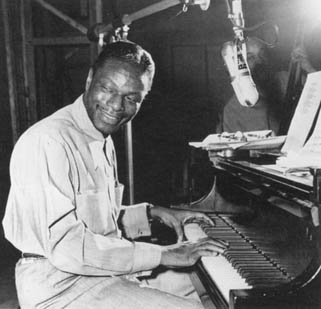
Originally a piano player, Cole’s singing career began in 1941 when he had to stand in for Billie Holiday.
As pianist and leader of a ground-breaking trio, Cole applied his natural brilliance and classical training to an intoxicating blend of jazz, pop, and blues. However, despite having such a profound instrumental influence, Cole is remembered mostly for the honey-smooth vocals and romantic ballads he performed later in his life.
Nathaniel Adams Coles (he dropped the “s” from his name in 1939) was born in March 1916. He was the son of a pastor and church choir director in Montgomery, Alabama. At the age of 4, shortly before his family migrated to Chicago, Cole began to learn the piano by ear. At the age of 12, he started classical piano lessons absorbing, at the same time, Chicago’s vibrant jazz culture. After high school, Cole began playing in Chicago’s many nightclubs.
Cole formed the King Cole Trio in 1939 with guitarist Oscar Moore and bassist Wesley Prince. Prince was later replaced by Johnny Miller. The trio’s innovative arrangements and virtuosity mixed swing, boogie-woogie, and novelty numbers with intricate instrumental passages. In 1943, an executive for the fledgling Capitol Records saw the trio in concert and signed them up. Weeks later, they cut “Straighten Up and Fly Right,” which shot up the rhythm and blues (R&B) and pop charts. Several other hits followed, including “Gee, Baby, Ain’t I Good To You?,” “I'm a Shy Guy,” and “Get Your Kicks on Route 66.”
In late 1946, Cole recorded two songs that wholly transformed his career. The first was the ballad, “(I Love You) For Sentimental Reasons,” which reached No. 1 on the U.S. pop charts. The second was “The Christmas Song,” which added a string section and cemented the Nat “King” Cole hit-making formula. From 1948, almost all of Cole’s recordings featured orchestral settings and arrangers such as Nelson Riddle or Billy May. These orchestrated recordings included “Nature Boy” (1948), “Mona Lisa” (1950), “Unforgettable” (1953), “When I Fall in Love” (1957), and “Ramblin' Rose” (1962), each selling millions of copies. Cole was one of the few African-American performers of that time to gain relative acceptance from the mainstream white audience, although that didn’t prevent him from being attacked on stage by a group of racists during a 1956 concert in Alabama.

Originally a piano player, Cole’s singing career began in 1941 when he had to stand in for Billie Holiday.
Cole died of lung cancer in 1965, leaving a musical legacy far beyond just a litany of fine ballads. The sophisticated style and smooth delivery of Cole’s band appealed to middle-class whites and upwardly mobile African-Americans, opening doors for pianists such as Erroll GARNER and Oscar Peterson. And, as a primary influence on Ray CHARLES, Charles Brown, and Amos Milburn, Cole was one of the architects of R&B.
Greg Bower
SEE ALSO:
BLUES; BOOGIE-WOOGIE; JAZZ; POP MUSIC; SWING.
FURTHER READING
Gourse, Leslie. Unforgettable: The Life and Mystique of Nat King Cole (New York: St. Martin’s Press, 1992);
Haskins, James, with Kathleen Benson. Nat King Cole (London: Robson, 1991).
SUGGESTED LISTENING
The Best of the Nat King Cole Trio 1942–46; The Complete After Midnight Sessions; Sweet Georgia Brown.